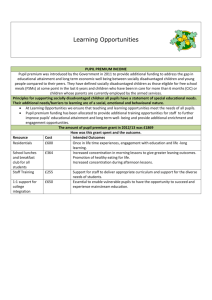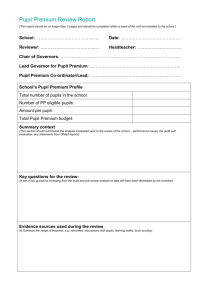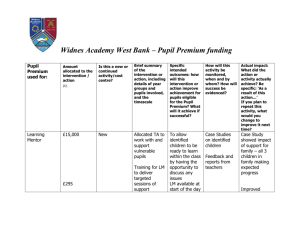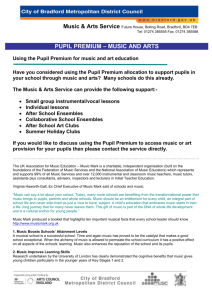The pupil premium: assessing the options Theory and Empirical Evidence 2010.
advertisement
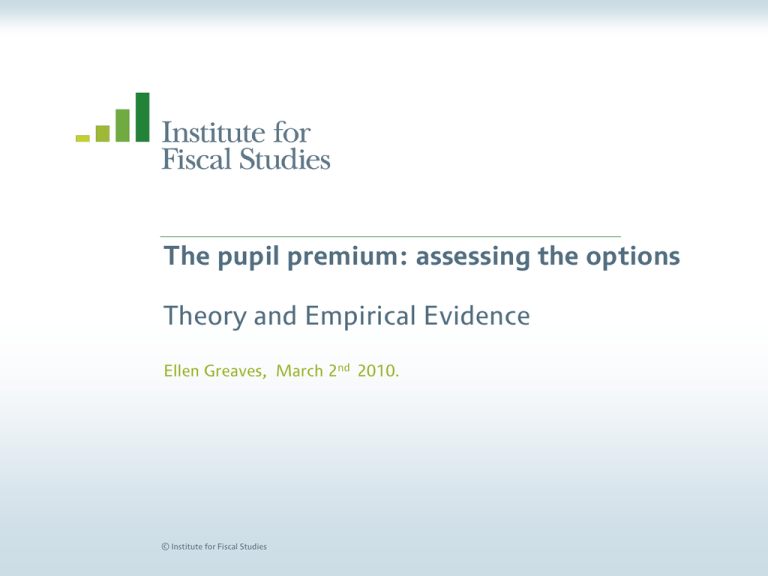
The pupil premium: assessing the options Theory and Empirical Evidence Ellen Greaves, March 2nd 2010. © Institute for Fiscal Studies Possible mechanisms for reducing the attainment gap Extra resources Pupil premium Change in mix of pupils across schools Increased competition New providers Specialist schools © Institute for Fiscal Studies Increase in attainment for disadvantaged students Direct effect of extra resources? • US – Hanushek (1997) summarises conventional wisdom – “there is not a strong or consistent relationship between student performance and school resources.” – Questioned by others • International evidence – Little correlation between spending and attainment (OECD) • UK – Some small but positive effects found for children going through school in 1970s – Other recent research finds small, positive effects of increasing resources – No clear differential effect for advantaged or disadvantaged pupils © Institute for Fiscal Studies Positive peer effects from a new school mix? • Schools in England are segregated by income and ability • School composition matters • Why are schools segregated? – Mostly residential segregation and catchment areas – Selection by parents? – Selection by schools? • Impact of the pupil premium? – Change the supply side – what pupils would schools prefer? – Change the demand side – what schools would parents prefer? © Institute for Fiscal Studies A new school mix? The supply side • Would schools respond to financial incentives? – Schools don’t behave like firms – But they do need extra resources to teach “hard-to-teach” pupils – Evidence from SEN premium (West et al, 2006) • Perhaps better to think about reducing the disincentive to attract disadvantaged pupils • Can schools choose their pupils? – Schools aren’t meant to “cream-skim” pupils – Schools Admissions Code prohibits covert selection – But some evidence they do in the current system (West et al, 2006; Allen and West, 2009) © Institute for Fiscal Studies A new school mix? The demand side • Do parents want high academic standards? – House price premium around “good” schools (Gibbons and Machin, 2001; Black, 1999) – Less incentive to pay this premium if the pupil premium raises attainment in other schools • Do parents want a “good” peer group? – Burgess et al (2009); Rothstein (2006); Schneider and Buckley (2002) – Effective resources per pupil? – Or “People like me”? © Institute for Fiscal Studies A new supply of schools • Context: Conservative proposals for new schools • Pupil premium interacts with this policy – Clearer funding system – Increase in resources available in disadvantaged areas • Would new schools be set up? – Chile , some states in the US, Sweden • Do new schools need the profit incentive? – Kunskapsskolan – largest provider of “free” schools “The company would not have existed were it not for investors” – Large number of non-profit and “non-market oriented” charter schools in the US – Much interest in proposals in the UK © Institute for Fiscal Studies A new supply of schools - benefits • Competition – A “tide that lifts all boats”? – Strongly debated • Specialist schools serving disadvantaged pupils – KIPP schools in 19 US states; Green dot schools in LA – Some evidence of positive results © Institute for Fiscal Studies A new supply of schools - disadvantages • Selection by new schools? – Some charter schools “crop” their intake, avoiding hard-to-teach pupils (Lacireno-Paquet et al, 2009) • Increase in segregation? – Chile - “massive exodus” of parents of high socio-economic parents from state schools (Hsieh and Urquiola, 2002) – UK - past reforms have led to no change in the level of segregation in schools (Gorard et al, 2002; Allen and Vignoles, 2006) • Segregation may not increase the attainment gap when there is extra funding for poorer pupils © Institute for Fiscal Studies Summary of empirical evidence • Direct effect of increasing resources – Evidence of small, positive effect – Reduce the attainment gap to some extent – How can/will extra resources be used? • Indirect effect of peer groups – Parents may have less incentive to pay a house price premium, but probably still care about peers “like me” – Likely that schools have little scope to change their intake, but it may reduce the disincentive for taking disadvantaged pupils • Indirect effect of increased supply – Likely that more schools will be set up – Could increase competition – More schools in disadvantaged areas (possibility for specialist schools) © Institute for Fiscal Studies
